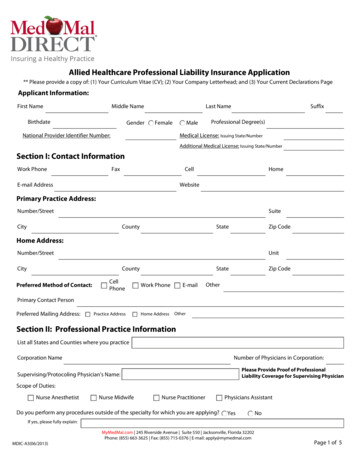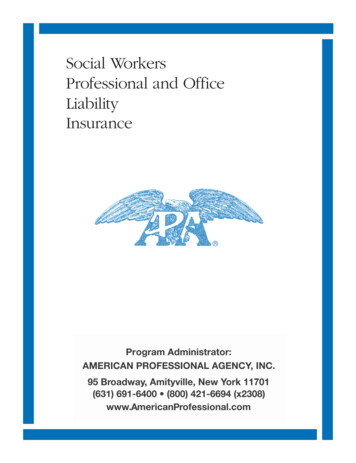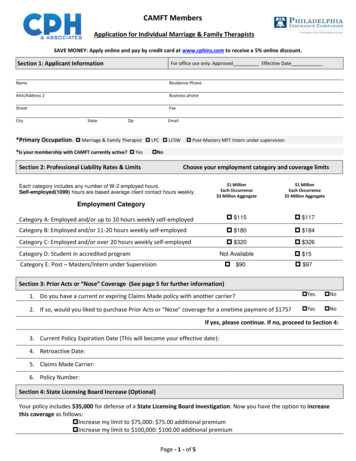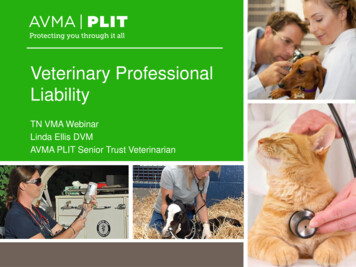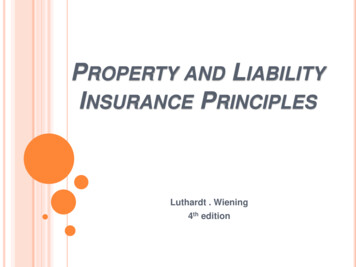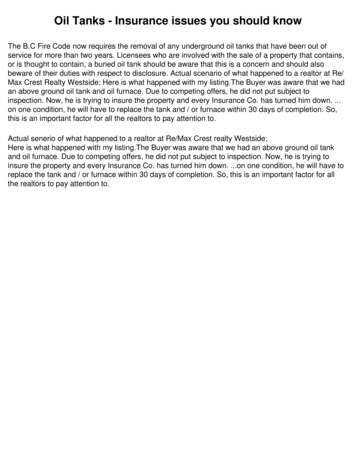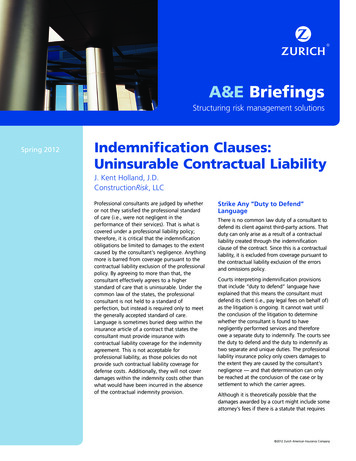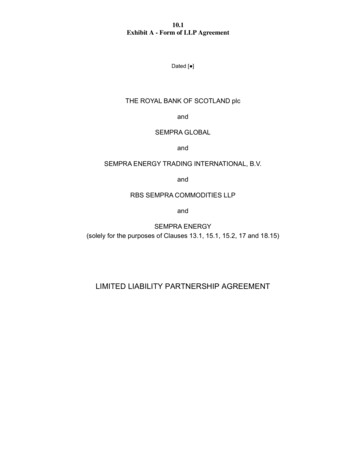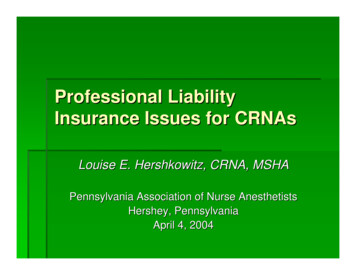
Transcription
Professional LiabilityInsurance Issues for CRNAsLouise E. Hershkowitz, CRNA, MSHAPennsylvania Association of Nurse AnesthetistsHershey, PennsylvaniaApril 4, 2004
What is It? A Contract for Service and Payment Insurer is provider of service (insurancecompany) Insured (CRNA) The Contract is secured by payment of aPremium
What is Covered? Expenses related to defending a CRNAagainst a medical malpractice claim,including: Investigation costsAttorney feesExpert witness feesIndemnity payment (costs associated with ajudgment or settlement)
How Can I be Covered? Individual Coverage Employer’s Policy Purchased or “self-insured”? Group or separate limits? Individually named?
Where do I get it? Medical Malpractice Insurance is aunique and specialized market, sospecialization is a real advantage Licensed Insurance Agents are requiredto follow state laws Staffing agencies are generally notlicensed to act as insurance agents, butmay have affiliations with licensed agents
How do I Choose an InsuranceCompany? Admitted vs. Non-admitted Admitted companies have policies approved byState Insurance regulators Rates are set Policy forms are approved Non-admitted companies do not require stateapproval Have no limits on rates or policy forms Are generally only legally offered to purchasers whohave been denied by Admitted companies
Who Might be DeniedCoverage? CRNAs with priorclaims CRNAs withincidence ofimpairment Substance abusePhysical limitationsGaps in practiceLicensing issuesOther risk factors Lack of “Tail”coverage (mayprovide “prior acts”coverage in certaincircumstances) Practice limitations New graduateRefresher candidatesOther “special”situations
How do you Choose anInsurer? Ratings Several sources, including A. M. Best: Oldest independent rate of insurance companies Based on perceived ability to pay claims Superior A , A Excellent A, AVery good B , B Lower rating indicate source of concern
Types of Policies Occurrence Cover claims generated by incidents during theperiod that the policy is in force Coverage regardless of when the claim is made Claims-made Cover claims which occur during the period that thepolicy is in force Claims must be made during the policy period Extended Reporting Period Endorsement (“Tail”) isrequired to cover claims filed after the policy period
Claims-made Policy Issues How long is your “Tail”? Some companies offer unlimited coverage St. Paul, TIG, CNA Some companies offer limited coverage Daily policies and non-admitted companies mayoffer only a one-year reporting period Definition of “Claim” Suit filed and served vs. any communicationabout an incident with potential for claim
Claims-made Policy Issues Premiums “Stair step” up over five year period as aresult of increasing likelihood of filing ofclaims Admitted companies have approved rates Non-admitted companies can charge whatthe market will bear Beware artificially low first year premiums
Liability Limits Per OccurrenceLimits Maximum paymentper claim For example: 1 million/ 3 million 1.7 million/ 5.1million Aggregate Limits Maximum paymentfor all claims in totalagainst the insured For example: 1 million/ 3 million 1.7 million/ 5.1million
Other Issues Consent to Settle Does insurer or insured have the right todetermine whether or not to settle? National Practitioner Data Bank Minimum Premium Is there a minimum charge even with earlycancellation on policy or “tail”?
Other Issues Deductible? Out-of-pocket costs to insured for legalexpenses even if no judgment or settlementis made Defense costs Are costs to defend a claim part ofoccurrence and aggregate limits or inaddition to those limits?
Employer Coverage Issues Occurrence or Claims-made? If Claims-made, is a “tail” available? Who pays for the “tail”?If employer pays, is written documentation of “tail”provided to the CRNA? If CRNA pays, what are the costs? If no “tail” is available, how will a claim filedafter the policy period be covered? Will there be a problem for the CRNA obtainingcoverage for his or her next position?
Employer Coverage Issues Written verification of coverage (e.g. Certificateof Insurance) “Self-insured”? If so, is the plan sufficientlyfunded? Which insurance company provides coverage?Ratings? Physician owned? Separate or group liability limits? If claim is made, is legal counsel provided? Consent to settle?
Employer Coverage Issues Checklist Does the professional liability insuranceprovided by your employer: Supply you with written verification ofcoverage? Apply to you by name in the policy? Have a separate limit of liability for you sothat coverage cannot be used up by claimsagainst others covered by the same policy?
Employer Coverage Issues Checklist Provide legal counsel representing your interestsabout who is at fault, even when that’s in conflictwith your employer’s allegations? Respond to all types of work you are performing foryour employer? Include a written agreement from your employer thatExtended Reporting coverage must be maintainedon your behalf at your employer’s expense after youleave your job? (and evidence that such coverage ismaintained?)
Employer Coverage Issues Checklist Advise you of settlement offers to thosesuing you before they are made? Advise you of the final disposition of anyclaims against you so that you know what isgoing to be reported to the NationalPractitioner Data Bank? Reimburse you for loss of income becauseyou are required to attend a trial orparticipate in pretrial meetings?
Employer Coverage Issues Checklist Respond to volunteer or moonlightingactivities outside of your principalworkplace? Provide legal counsel for depositions youare required to attend even if your are notnamed in the lawsuit? Reimburse for costs of legal representationfor licensure and/or administrative review?(See AANA Insurance Website:aana.com/members/insurance for further information)
Current Issues CNA November 12, 2003 decided to take 1.5 billion aftertax charge to strengthen reserves 332 millionafter tax charge for insurance and reinsurancereceivables As a result, reported net loss of 1.8 billion for thirdquarter 2003 Claims are mostly for 2000 and earlier, and forasbestos, environmental and mass tort claims, notfor medical malpractice claims Maintains its A. M. Best A rating after the charges
Current Issues Tort Reform Hot issue in state legislatures and Congress Large judgments are perceived as threat toinsurance company reserves Fewer insurers are willing to compete in medicalmalpractice market Higher rates are driving providers out of practice Investment markets have not produced cushion forincreased payments
Current Issues CRNAs have access to malpracticeinsurance in all states CRNA rates have not increased at levelof many other healthcare providers CRNAs need to understand theintricacies of medical malpracticeinsurance in order to protect their assetsand professional practices
Medical Malpractice Insurance is a unique and specialized market, so specialization is a real advantage Licensed Insurance Agents are required to follow state laws Staffing agencies are generally not licensed to act as insuran
